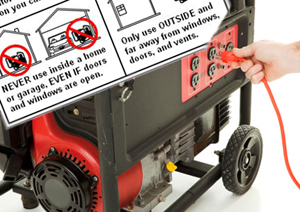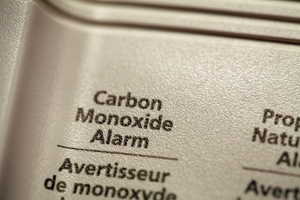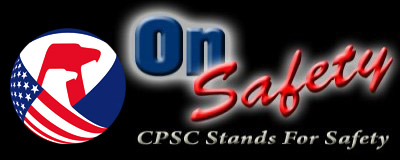OnSafety is the Official Blog Site of the U.S. Consumer Product Safety Commission. Here you'll find the latest safety information as well as important messages that will keep you and your family safe. We hope you'll visit often!
|
By CPSC Blogger on February 20, 2013
Blog in English
Recientemente dos mujeres murieron en Chicago por intoxicación con monóxido de carbono (CO), según las noticias de Telemundo Chicago. El noticiero informó que se sospecha, que el causante fue un calentador defectuoso. Por otra parte, en Oxford, Connecticut, un hombre falleció supuestamente debido a altos niveles de CO hallados en una casa que estaba cuidando. Los perros en la casa también murieron (Connecticut Post, 1/30/13).
Estas muertes reportadas son solo dos de entre otros trágicos sucesos que nos recuerdan que el monóxido de carbono es un asesino. De hecho, el CO es llamado el “asesino invisible”, porque usted no puede detectarlo a través de los sentidos, ya que no tiene color, olor ni sabor. Evite ser víctima de este “asesino silencioso”.
La mejor forma de prevenir la intoxicación por monóxido de carbono en su hogar es:
- Haga que un profesional chequee anualmente los equipos de calefacción por quema de combustible que posee en su hogar – caldera, chimenea, calentador de agua, etc. – para asegurarse de que están funcionando adecuadamente.
- Instale alarmas de monóxido de carbono en todos los niveles de su casa y en las áreas fuera de sus dormitorios.
- Si usted utiliza un generador cuando hay un apagón, manténgalo en el exterior, lejos de puertas y ventanas. NO USE un generador en su garaje.
Las muertes por monóxido de carbono son mucho más comunes de lo que pudiera imaginarse. Según un nuevo informe de la CPSC (Comisión de Seguridad de Productos del Consumidor de EE.UU.):
- Cada año entre el 2007 y el 2009 hubo un promedio de 169 muertes no intencionales y no asociadas al fuego debidas a la intoxicación por CO.
- 1/3 de las muertes fueron asociadas al monóxido de carbono proveniente de sistemas de calefacción, tales como calderas.
- Más del 40% de las muertes por monóxido de carbono ocurren por usar generadores, operándolos en un garaje o sótano, lo cual es extremadamente peligroso.
- La mayoría de las muertes por CO ocurren en los meses más fríos del año: noviembre, diciembre, enero y febrero.
Además de los peligros del monóxido de carbono, también los calefactores portátiles tienen que ser operados con extremo cuidado para prevenir incendios no intencionales. Los calefactores portátiles están relacionados con un promedio de 100 muertes cada año entre el 2008 y el 2010.
Apenas la semana pasada, funcionarios locales de bomberos señalaron a los calefactores portátiles como la supuesta causa de incendios en hogares de Portsmouth, Va. (vía el canal de TV Fox 43) y Bristol Township, Pa. (en PhillyBurbs.com).
- Apague el calefactor portátil cuando vaya a dormir o a salir de la habitación.
- Mantenga el calefactor portátil al menos a tres pies de cualquier objeto que pueda incendiarse, incluyendo cortinas y muebles.
Asegúrese de tener alarmas de humo en buen funcionamiento en todos los niveles de su casa, fuera de las áreas de los dormitorios y dentro de cada dormitorio.
Busque información adicional para salvar vidas en el Centro de Información sobre Monóxido de Carbono de la CPSC.
This address for this post is: http://www.cpsc.gov/onsafety/2013/02/mantengase-seguro-chequee-su-calefaccion/
By CPSC Blogger on February 8, 2013
Blog en español
Two women are reported to have died from carbon monoxide poisoning recently in Chicago, according to the Chicago Tribune. The newspaper reports that a faulty boiler is suspected. Elsewhere, in Oxford, Conn., a man reportedly died due to high levels of carbon monoxide (CO) found in a home where he was housesitting. The dogs in the house died, too. (Connecticut Post, 1/30/13).
These reported deaths are just two of the regular, tragic reminders we see that carbon monoxide is a killer. In fact, CO is called the “invisible killer,” because you can’t see, smell or taste it. Don’t let this happen to you.
The best way to prevent carbon monoxide poisoning in your home is to:
- Have fuel-burning home heating appliances – your furnace, chimney, water heater, etc. – checked by a professional every year to make sure they are working properly.
- Install carbon monoxide alarms on every level of your home and outside bedroom areas.
- If you use a generator when the power goes out, keep it outside, far from windows and doors. Do NOT use a generator in your garage.
Carbon-monoxide deaths are more common than you might think. According to a new CPSC report:
- There were an average of 169 unintentional, non-fire CO poisoning deaths each year between 2007 and 2009.
- 1/3 of the deaths were associated with carbon monoxide from heating systems, such as furnaces.
- More than 40% of carbon-monoxide deaths are from using generators, such as operating them in a garage or basement, which is extremely dangerous.
- Most CO deaths occur in the colder months of the year: November, December, January and February.
In addition to carbon monoxide risks, space heaters also need to be handled with extra care to prevent unintentional fires. Space heaters are associated with an average of 100 deaths each year between 2008 and 2010.
Just last week, local fire officials reportedly blamed space heaters for fires at homes in Portsmouth, Va. (via Fox 43-TV) and Bristol Township, Pa. (via PhillyBurbs.com).
- Turn the space heater off when you go to sleep or leave the room.
- Keep the space heater at least three feet away from anything that can burn, including curtains and furniture.
Have working smoke alarms on every level of your home, outside bedroom areas and inside each bedroom.
Look for additional life-saving information in CPSC’s Carbon Monoxide Information Center.
This address for this post is: http://www.cpsc.gov/onsafety/2013/02/be-safe-check-your-home-heating/
By CPSC Blogger on November 8, 2012
 Are you getting your power from a portable generator? Do you have a neighbor who is still waiting for the power to be restored after Hurricane Sandy and the Nor’easter? Are you getting your power from a portable generator? Do you have a neighbor who is still waiting for the power to be restored after Hurricane Sandy and the Nor’easter?
The aftermath of a storm can sometimes be a time when people take risks. Do not make your generator placement one of those risks. It can have deadly consequences for you and your family. Since Hurricane Sandy hit, more than a dozen people in the Northeast have died from carbon monoxide, or CO, poisonings from generators, according to news accounts.
Generators need to be placed outside, away from windows and doors. They do not belong in garages or basements. Opening the garage or basement door does NOT provide enough ventilation to save you from the deadly gas.
Share this information with anyone you know in the affected areas. If you are in a storm-affected area and hear a generator running in your neighborhood, share this information with its owner.
If you’re running a generator, make sure you have a working CO alarm in your home. Even if you aren’t running a generator, install a CO alarm. This alarm can save your life. The initial symptoms of CO poisoning are headache, fatigue, shortness of breath, nausea and dizziness.
Here’s more information on carbon monoxide.
This address for this post is: http://www.cpsc.gov/onsafety/2012/11/move-your-generator-out-of-the-garage/
By CPSC Blogger on June 15, 2012
Dads do lawnmowers. Dads do grills. This Father’s Day, give your dad the information that will help him do what he does safely.
Each year, about 110 people die and about 87,000 people are treated in emergency rooms from injuries associated with power lawnmowers. This includes walk-behind mowers, riding mowers, lawn tractors and garden tractors.
If you’re buying dad a new walk-behind rotary lawn mower, consider these factors. Then remind him about safety:
- Fill the fuel tank before starting the engine. NEVER refuel when the mower is running or hot.
- Pick up twigs, rocks and other debris before you mow. The whole family can help with this. Just make sure that children clear the area before the actual mowing begins.
- Cut dry grass, not wet grass. Wet clippings could jam the rotary blade and shut down the engine. When you need to remove clippings from the discharge chute, STOP the mower.
- Push the mower forward. Don’t pull it backward.
- On lawn slopes, if you are using a walk-behind rotary mower, mow across the slope. If you drive a riding mower, drive up and down the slope, not across it.
- Check safety features often and repair or replace them if needed. Do not remove any safety devices from a mower.
- When using an electric mower, organize your work so you first cut the area closest to the electrical outlet and then gradually move away. This will minimize your chance of running over the power cord and getting electrocuted.

As for the grill, here’s a maintenance and safety checklist for gas grills. Give him these key points:
- Check the grill’s hoses for cracking, brittleness, holes and leaks. The hose or tubing shouldn’t have any sharp bends.
- Hoses need to be as far from the hot surfaces as possible. Don’t let grease drip on them.
- Any time you reconnect a grill to the LP gas container, or if you smell gas, check for leaks. To do this, open the gas supply valve fully and apply a soapy solution (one part water, one part liquid detergent) with a brush at the connection points. If you see bubbles, there’s a leak. Turn off the gas, tighten the connection and test again. If you can’t stop the leak, replace the leaking parts.
- Do NOT light a grill if you detect a leak.
On average, about 3,600 people are treated in emergency rooms each year from injuries associated with gas, charcoal or propane grills. Of the 12 deaths each year associated with grills, about two-thirds are from carbon monoxide poisoning when a grill is used in an enclosed space like inside a house.
When grilling, always follow these safety tips:
- Only use a grill at least 10 feet away from your house or any building. Do not grill in a garage, breezeway, carport, porch, or under any surface that will burn.
- Never leave a grill unattended.
- Keep children away from the grill. The outside surface can burn when touched.
- Always follow the instructions that came with the grill.
All of this advice is meant to ensure that dad doesn’t spend Father’s Day in the emergency room. Have a happy and safe Father’s Day!
This address for this post is: http://www.cpsc.gov/onsafety/2012/06/safety-for-dad/
By CPSC Blogger on March 7, 2012
It’s Time Change Sunday. Yes, again. And that means it’s time to remind you to change your smoke and carbon monoxide (CO) alarm batteries.
Occasionally, we tell you about deaths in homes without working alarms. We hear these tragic stories on the news regularly or see them posted online.
But, for Daylight Saving Time this year, we want to remind you of some positive stories. These are anecdotal, as they are told through the eyes of the media and we haven’t investigated any of the facts ourselves in these cases. But they show lifesaving information about having working smoke and CO alarms in your home.

The first story comes from KSAT in San Antonio, Texas. An apartment dweller told KSAT that she installed a carbon monoxide alarm at the advice of a friend. Because of the beep of that alarm, the residents of an entire apartment building were evacuated and saved from a building with high levels of carbon monoxide, a gas that you can’t see or smell, but which can kill you.
The second story comes from BayToday in North Bay, Canada. A mom reports that she and her daughter were feeling nauseous and thought they were getting sick. An alarm was beeping, and the mom asked her husband to go turn it off. Instead of turning the alarm off, the father looked at the alarm, saw the carbon monoxide levels and got the family out of the house. Another story about a tragedy that was prevented.
So remember, buy some new batteries and take a few minutes this weekend to install them in all of your smoke and CO alarms. Then, make sure to test the alarms every month to make sure they are working.
Editor’s Note: The opinions expressed in this OnSafety blog do not reflect CPSC endorsement of any product.
This address for this post is: http://www.cpsc.gov/onsafety/2012/03/working-alarms-save-lives-really/
|
|










